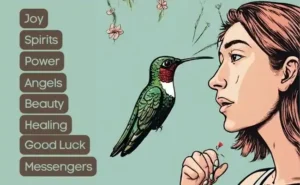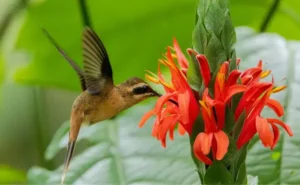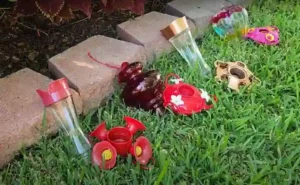Idaho may not be the first place that comes to mind when you think of hummingbirds, but this rugged state is home to some special species of these tiny birds. With varied terrain from high mountain ranges to arid deserts, Idaho provides diverse habitats that hummingbirds have adapted to call home. They bring a burst of color and energy to the state’s birdlife.
As ambassadors of vitality and beauty, hummingbirds in Idaho serve as a reminder of the delicate balance and interconnectedness within the state’s thriving natural world.
Here I share some of my encounters with these feathered creatures during my hiking adventures and in my garden in Idaho.
Ready to explore hummingbirds in Idaho? Let’s first dive in to explore what Idaho state is.
Table of Contents
Landscape of Idaho
Idaho has a remarkably diverse landscape spanning multiple geographic regions. Idaho has nearly every landform – lofty mountains, expansive plains, and dramatic river landscapes, contributing to both the state’s unique ecology and the ways residents connect with the land.
Here are some of the main landforms and features:
Mountains
Idaho is known as the Gem State in part because of its numerous mountain ranges. The state has portions of several major ranges:
- The Bitterroot Range in the north forming part of the Rocky Mountains
- The Clearwater Mountains in the north-central part of the state
- The Sawtooth Mountains located in central Idaho with high steep peaks
- The Salmon River Mountains are known for river gorges cutting through
- The Lost River Range and other mountains in eastern Idaho
These mountain ranges feature tall snow-capped peaks, alpine meadows, coniferous forests, and fast-flowing rivers and streams. They provide vital habitat for wildlife. The mountains also offer plenty of recreational opportunities like hiking, fishing, and skiing.
Plateaus
Between the mountain ranges lie expansive plateaus and intermontane valleys. These include the Columbia Plateau stretching across southern Idaho.
These high-elevation plains historically had grassland habitats before extensive agriculture use. The Snake River Plain features volcanic buttes and craters as signatures of past volcanic activity in the region.
Rivers
Abundant rivers drain from the mountains, slicing through gorges in places. Major rivers include the Snake, Salmon, and Clearwater Rivers plus part of the Clark Fork in the north. These rivers and their tributaries provide crucial freshwater ecosystems in this largely arid state. The rivers support wildlife habitats and recreational activities.
Lakes and Canyons
Glaciation and geological forces also carved out subalpine lakes across central and northern Idaho with Lake Pend Oreille being the largest. In southwest Idaho, the Snake River has carved steep canyon walls through the plain. The Snake River Canyon is up to 2,000 feet deep in places, creating dramatic views and providing sheltering habitat for species like birds of prey.
Exploring the Diversity of Hummingbirds in Idaho
Hummingbirds in Idaho are adaptable and can thrive in various environments, from mountainous regions to valleys. They prefer open areas with abundant flowers, making meadows, gardens, and parks ideal habitats. These birds play a crucial role in pollination, enhancing the biodiversity of the flora in their surroundings.
One fascinating aspect of hummingbirds in Idaho is their territorial behavior. These birds are known for their aggressiveness, often chasing away other hummingbirds from their feeding territories. This behavior ensures that they have exclusive access to nectar sources.
Among the various species, the Rufous Hummingbird, Calliope Hummingbird, Broad-tailed Hummingbird, Black-chinned Hummingbird, and Anna’s Hummingbird are commonly spotted. These small avian creatures are a part of the state’s wildlife that attracts with their glittering beauty.
If ever you get a chance to visit Idaho, You can find calliope hummingbirds and rufous hummingbirds in the north of Idaho. The broad-tailed hummingbirds are found in the areas between central and southern Idaho. Anna’s hummingbirds are also seen in these areas in the September-December. During summer, Black-chinned hummingbirds appear everywhere in Idaho.
Hummingbirds have a high metabolism and they flatter their wings with very high speed, you can also call them nature’s little helicopters. They seem to always be on the move. Here is a comprehensive guide to the species in Idaho.
Rufous Hummingbirds
Being a resident of Idaho, I have seen many Rufous Hummingbirds here, especially during the summer breeding season. Gorget colors can help you identify Idaho’s hummingbirds. The male Rufous Hummingbird has an iridescent red throat, while the female has green back and tail feathers that are banded white, black, and grey-green.
Every day, about a dozen Rufous hummingbirds visit my backyard. These small, lively birds are found all over Idaho, from the mountains to the valleys. They like open areas with flowers, such as gardens and meadows.
It’s fun to watch them because they are quite bossy and often chase away other hummingbirds from their food. Their colorful feathers and quick movements make my backyard feel like a special place where nature comes to life. It’s a simple but wonderful daily experience to share my space with these little feathered friends.
- Range – The Rufous Hummingbird goes farther north than any other hummingbird. It spends the winter in Mexico and migrates to breeding grounds as far away as Alaska.
- Nesting – For breeding, they prefer second-growth forests. They also use older forests, parks, and neighborhoods, anywhere from sea level up to 6,000 feet.
Calliope Hummingbirds
The Calliope hummingbird is the smallest bird in North America, it is just 3 inches long. You can identify male easily from their bright greenish backs. Calliope hummingbirds have a gorget, which is a patch of iridescent feathers on their throat, made up of purplish-red stripes, and it resembles the pattern of a peppermint candy.
The Intermountain Bird Observatory in Idaho conducts hummingbird banding in the Boise National Forest and during a banding operation when a female Calliope Hummingbird was recovered she was 8 years and 1 month old.
A Calliope Hummingbird has a weight approximately equal to that of a dime and despite its small size, it can survive the chilly nights in Idaho. In Idaho, the small calliope hummingbirds have shorter beaks compared to other hummingbirds in the region. This enables them to feed on flowers with short tubes, such as scarlet gilia.
- Range – They travel almost 5400 miles each year, migrating from their winter homes in southern Mexico to nest in the northern Rocky Mountains, and the fun fact is that it smallest long-distance migratory bird in the world.
- Nesting – They like to build their nests in montane conifer forests, especially in areas that have shrub-sapling growth following fires or logging. They breed mostly in mountain areas at middle elevations like 4,000 to 7,000 feet.
Broad-Tailed Hummingbird
The Broad-tailed Hummingbird is one of the common hummingbird species found in Idaho. If you are in southern Idaho and see a hummingbird with a rosy-red gorget, it is a broad-tailed hummingbird.
I will never forget the moment when I first saw the Broad-tailed hummingbird, I was at my university going back home when suddenly 3 hummers came and started feeding on the flowers in front of me.
They were large as compared to the calliope hummingbird, I think they were about 4 inches long. Broad-tailed Hummingbirds mainly feed on nectar from flowers such as red columbine, Indian paintbrush, sage species, currants, and scarlet mint.
They stay in Idaho just for a few months from late May to early August. Idaho has cold nights during the winters and to deal with the cold, hummingbirds enter a form of nighttime hibernation known as torpor. During this hibernation, the metabolism of the hummingbirds slows down to conserve energy.
The Broad-tailed Hummingbird has been observed in various counties in Idaho, including Ada, Bannock, Bear Lake, Bingham, Blaine, Boise, Bonneville, Butte, Caribou, and Cassia.
- Range – Its migratory breeding populations extend north along the Rocky Mountains to southern Montana and west through forested areas of Nevada, just reaching into eastern California.
- Nesting – These birds live high up in the mountains, as tall as 10,500 feet. It can get really cold there, even in the summer, with temperatures dropping below freezing.
Black-Chinned Hummingbird
You can easily find black-chinned hummingbirds in Idaho. I see them almost whenever I look at the hummingbird feeders in my backyard. Black-chinned hummingbirds are recognized for their vibrant purple throat feathers. If it’s summer season, you can see them often at the Treasure Valley in Idaho.
They are commonly found as summer breeding residents throughout Idaho. The males have black and violet gorget which is why they are named as Black-chinned. These are the most common birds in Idaho at very low elevations, I have found some of their nests nearly 100 meters high.
They usually arrive in mid-April through mid-May, with some as late as mid-June, and typically leave in September. They can catch insects during flight. They are one of the most adaptable of all hummingbird species and can be found in various habitats.
- Range – Black-chinned Hummingbirds are found in Idaho and Montana, in the mountain and alpine meadows, canyons with thickets, orchards, and urban areas.
- Nesting – The Black-chinned Hummingbird typically nests in a tree or shrub, usually 4-8 feet above the ground.
Anna’s Hummingbird
I have not seen many Anna’s Hummingbirds in Idaho but they are known to spend their winters in Idaho, particularly in the Treasure Valley and the West Central Mountains. The males have a red on the crown of their head.
They arrive in October and leave in March, staying during the coldest months of the year. Anna’s Hummingbirds possess an enlarged vocal center in their brain that other hummingbirds do not have. Anna’s Hummingbirds have a distinctive song.
The first Anna’s hummingbird was spotted in 1976 in southwestern Idaho. Luckily, I encountered a beautiful one when I was enjoying the hummingbird trail, located south of Twin Falls.
The Intermountain Bird Observatory has been studying their winter presence in Idaho since 2015 and has seen an increase in the number of reported sightings. The ornithologists are trying to understand why Anna’s hummingbirds started spending winters here in Idaho.
These hummingbirds can survive the cold by eating a high proportion of insects as part of their diet, which provides them with the necessary protein fuel, along with nectar and even tree sap.
- Range – Primarily found along the Pacific Coast, from southeast Alaska to Baja California in Mexico. Interestingly, their range has expanded significantly in recent decades due to factors like the availability of backyard feeders and introduced flowering plants.
- Nesting – Females build cup-shaped nests using plant fibers, spiderwebs, and other materials. Nests are usually placed on horizontal branches of trees or shrubs, often near nectar sources.
Hummingbird Habitats in Idaho
Mountain Meadows
Idaho’s high mountain meadows provide an ideal summer breeding habitat for hummingbirds like Ruby-throated and Calliope hummingbirds. These meadows are filled with wildflowers like Indian paintbrush, columbine, and fireweed – important nectar sources. The meadows also have bushes and scattered trees that hummingbirds use for nesting spots and perches. I’ve watched hummingbirds darting from flower to flower in these meadows every summer while hiking the mountains.
Riparian Corridors
The riparian areas along rivers and streams in Idaho offer critical habitat, especially in otherwise arid regions. Lush vegetation and flowering plants thrive along the waterways. Trees like cottonwoods, aspens, and locusts provide nesting sites.
These Linear corridors allow hummingbirds to follow flower bloom progression during migration. The dappled sunlight by the water offers ideal conditions for catching insects too. Hummingbird sightings are practically guaranteed if you hike along riparian trails.
Backyard Gardens
More and more Idaho residents are landscaping their backyards with hummingbird-friendly flowers and providing feeders. Backyards can double as oasis-like stopover habitats during migration or additional habitat space for local hummingbird populations.
Flowers like bee balm, trumpet vines, petunias and native columbines help attract hummingbirds. They appreciate small trees, shrubs and fences for convenient perching between garden visits. I always enjoy watching “my” resident hummingbirds make the rounds through my garden all season. A water mister placed nearby gives them a convenient bathing spot too!
By improving wild habitat spaces and transforming our own backyards into welcoming spaces for hummingbirds, we can support special species like these captivating tiny birds.
Creating a Hummingbird Haven in Your Backyard
My backyard is a daily haven for around a dozen hummingbirds, turning ordinary days into enchanting experiences. Creating this haven has been incredibly rewarding, and attracting these tiny marvels is surprisingly simple. By adding colorful flowers and strategically placing feeders, I’ve turned my space into a hummingbird haven.
Witnessing their playful dances and vibrant presence has deepened my connection to nature. I’m inspired to share the joy, as anyone can transform their backyard or garden into a lively landscape of hummingbird wonders with just a few thoughtful steps.
- Plant Flowers: Hummingbirds love flowers that are bright and vibrant. Plant different kinds, like trumpet vine, bee balm, or salvia. They like different colors and sizes, so go ahead and put together a bunch of different flowers.
- Hang Up Hummingbird Feeders: One of the best ways to observe Idaho’s hummingbirds is to put up a hummingbird feeder. Choose a red-accented feeder and make your nectar by mixing four parts of water with one part of granulated sugar. Hang the feeder somewhere safe, and don’t forget to clean it often.
- Provide Perches: Give hummingbirds places to rest. They love to do this. You can use natural things like trees and bushes to make perching spots, or you can make your own with small swings, dowel rods, twigs, and plants.
- Clean Up the Garden: A clean garden with well-maintained flowers and feeders is inviting for hummingbirds. Cut back plants that are getting too big, get rid of dead leaves, and keep the area clean.
- Create a Water Source: Hummingbirds not only drink water but also like to bathe. Set up a birdbath or misting system for their enjoyment.
I have planted almost all types of flowers in my garden but the favorite feeding plants for hummingbirds in Idaho are
- Anise Sage
- Hummingbird Mints
- Flowering Maple
- Trumpet honeysuckle
- Texas Sage
- Red Hot Poker
- Bee Balm
- Penstemon barbatus
You can attract a lot of hummingbirds by planting these flowers, and if you want to attract more hummingbird birds then you must read my comprehensive guide in which I revealed all the secrets to attract hummingbirds.
Attracting Hummingbirds
While hiking natural areas offers great opportunities for hummingbird sightings, you can also attract them to backyards and gardens by providing nectar feeders and flowering plants. Some easy nectar favorites include bee balm, columbine, fuchsia, petunias, and native wildflowers like Indian paintbrush.
I like to sit watching my nectar feeder on summer afternoons, waiting to get quick glimpses of hummingbirds zooming in for a drink. Listening for the buzz of their wings and seeing their jewel-bright colors brings me so much joy. With a little effort, you may attract some of these aerial dancers to your own yard too!
Conclusion
Hummingbirds in Idaho brings not only vibrant beauty but also an integral connection to nature. Their presence, whether in backyard gardens or open spaces, instills joy and a deeper appreciation for the environment. The annual migrations of species like the Rufous Hummingbird highlight the importance of preserving habitats along their routes, emphasizing our role in environmental conservation.
As Idahoans welcome these tiny ambassadors into their lives, creating hummingbird-friendly spaces becomes a meaningful act of contributing to biodiversity and embracing our responsibility as stewards of the natural world. Getting to observe these energetic pollinators is one of my favorite parts of hiking Idaho’s incredible terrain.
So next time you’re out on a mountain trail or just working in your garden, keep an eye out for darting hummingbirds. If you spot one hovering close by, consider yourself lucky to witness one of nature’s most graceful and astonishing creatures. If you want to enjoy watching hummingbirds, you can go to Brockman’s hummingbird feeding station or the hummingbird trail near Twin Falls. Every little thing you do for hummingbirds matters a lot.
FAQs
What Are The Common Species Of Hummingbirds Found In Idaho?
I have observed five common species of hummingbirds in Idaho, which include Rufous, Calliope, Broad-tailed, Black-chinned, and Anna’s Hummingbirds.
When Is The Best Time To See Hummingbirds In Idaho?
The best time to see hummingbirds in Idaho is during the summer months, from late spring to early fall. There is a hummingbird feeding area in Idaho where you can see a lot of hummingbirds. That is Brockman’s hummingbird feeding station barely above the sagebrush flats as you go along Shoshone Basin up to the lodgepoles.
How Can I Create A Hummingbird-Friendly Garden In Idaho?
To create a hummingbird-friendly garden in Idaho, plant bright and vibrant flowers like trumpet vine, bee balm, and salvia. You can hang up red-accented hummingbird feeders with a sugary nectar mixture of four parts water to one part granulated sugar. Provide perches and a water source for bathing.
What Are The Migratory Patterns Of Hummingbirds In Idaho?
The hummingbirds in Idaho follow migratory patterns, with species like Rufous migrating from Mexico to breeding grounds as far north as Alaska. Calliope Hummingbirds travel approximately 5400 miles from southern Mexico to nest in the northern Rocky Mountains.
Are There Endangered Hummingbird Species In Idaho?
As of now, there are no known endangered hummingbird species in Idaho.
What Types Of Feeders And Food Attract Idaho Hummingbirds?
Idaho hummingbirds are attracted to feeders with red accents. Homemade nectar, made with a mixture of four parts water and one part granulated sugar, can be used. Planting hummingbird-friendly flowers like trumpet honeysuckle, red hot poker, and bee balm also attracts them to gardens.




